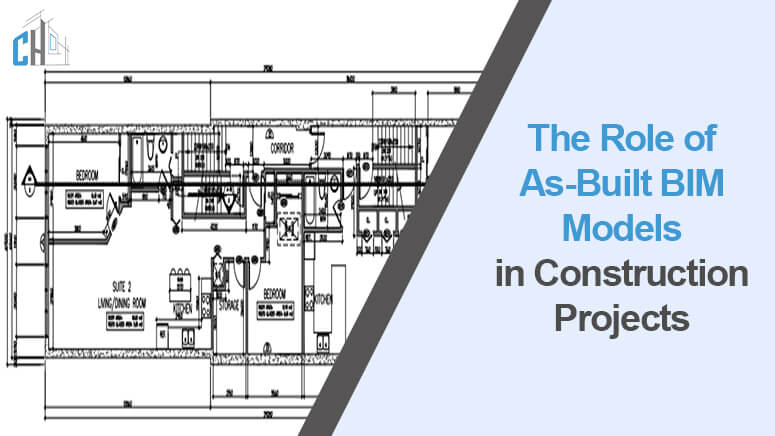Quick Summary: As-built BIM construction project practices can only be completed with as-built BIM models. They give true and timely pictures of a building’s status so that teams are equipped with data at any given time in a project.
These models make it easy to work together, minimize repetition and overlap, and reduce the wastage of resources by providing a cross-sectional picture of what is already in place.
There is considerable value in comprehending how to incorporate as-built BIM models since it leads to better project delivery and results.
Building Information Modeling (BIM) has emerged as the transformative technology affecting construction businesses to design, build, and manage built environment assets. One of the key uses of BIM is in developing As-Built BIM Models which depict a construction project at the conclusion of construction.
Whether you’re a construction professional, hire dedicated BIM specialist, or part of an as-built BIM modeling services company, understanding the significance of As-Built BIM can help optimize your projects, from planning to facility management.
This blog dives into what these models are, their benefits, and their role across different project phases—and even forecasts where this technology is head.
What Are As-Built BIM Models?
As-built BIM Models are details of a constructed project that is in use. While design BIM models provide the construction team with the plans develop before the project is undertaken, as-built models capture any changes that were made on site.
In other words, they are a true representation of the overall final structure, and even the fine geometric and spatial properties, and parts and sub-systems of a system.
These models are critical in the overall as-built drafting & drawing services operations as they enhance communication and improve organizational and project decisions for stakeholders engaged in construction ventures.
The implementation of BIM technology has continued to grow over the last few years as more organizations in the construction industry embrace the technology. In the contemporary world, as-built models are Building Information Modeling (BIM) documents not only for documentation alone but also for built asset management.
What Are the Benefits of As-Built BIM Models?
The as-built BIM models are very vital in construction practices since they enhance the efficiency of the construction processes and increase the accuracy of the projects in several phases.
Improved Project Visualisation
This is the advantage of having 3D modeling in Revit for the construction phase because traditional construction documentation has been known to cause misunderstanding and misconceptions because previous documentation consists of 2D construction drawings.
Architects, engineers, and even facility managers get to visualize how the full scale of the project has been realize to reduce conflicts and misunderstandings.
Accuracy and Efficiency
With the help of as-built Revit modeling services, accurate documentation of every detail, from structural changes to system installations, is ensured. This precision aids in:
- Minimizing discrepancies between planned and executed work.
- Allowing seamless updates to project databases.
- Improving the long-term maintenance of facilities.
Cost and Time Savings For Clash Detection
One of the most impactful contributions of as-built models is their ability to pre-empt conflicts between different systems—such as mechanical, electrical, and plumbing (MEP).
Methods such as clash detection can be use to detect problems before construction errors cost a lot of money. Such an approach also helps to minimize time losses and other unplanned costs to a very large extent.
As a result of using as-built modeling services, companies will reduce their expenses while at the same time offering quality work in the market.
The Role of As-Built BIM in Different Phases of a Project
As-built BIM models serve as a critical pillar throughout various phases of a construction project, offering precision and clarity at every stage—from initial inception to the final handover and beyond.

Pre-Construction Phase
As–built data is particularly useful in the planning stage because data from previous projects can be use. For example, historical models implemented into the as-built model development and the record modeling enable the stakeholders to evaluate difficulties met previously in new designs.
Moreover, the online working platforms of the BIM modeling services let every architect engineer, and contractor on the same page the moment they get to the drawing board to start the project.
Construction Phase
Construction sites can characterized by certain flexibility in construction work plans, and many unexpected changes may occur in any construction project.
As-built drafting & drawing services mean any adds can be continuously integrate into the model as the building progresses. This allows site conditions to be match with the design to avoid misunderstandings and to give direction to the whole team.
In broader construction projects, the 3D BIM as-built modeling is use to oversee the construction to see if the physical construction matches the virtual one.
Post-Construction Phase
I believe that as-built BIM models are most valuable at the post-construction stage of construction. Documentation of the as-built information becomes critical when transferring information to the client, and the actual configuration of the structure is reveale.
For facility managers, these are concepts of ‘digital twins’, where they have the power to manage, serve, repair, and increase the efficiency of the building without significant interruption. When organizations hire companies for as-built Revit modeling services they usually liaise with facility managers to provide the data with maximum staying power.
Future Trends and Technologies in As-Built BIM
The evolution of as-built BIM modeling services is still ongoing. Advances in technology are driving even smarter and more efficient applications of as-built models.
AI and Machine Learning Integration
It is expect that AI and machine learning will provide performance predictions that are derive from as-built information. For instance, AI could detect how strong a structure or how energy-efficient the building is depending on the current and past state.
Greater Use of Reality Capture Tools
There are no better tools than drones and 3D laser scanning when it comes to reality capture of site conditions. These technologies are integrate into the as-built modeling services workflows to enhance the speed of detailed and accurate as-built modeling.
Digital Twins for Ongoing Management
This idea is now also more widely referre to as the ‘digital twin’. They are real-time dynamic built models linked to buildings’ control systems. In the future, many companies are expected to embrace this technology as a better way of managing assets with more intelligence.
Cloud-Based Collaboration Platforms
It will also bring extensiveness to the cloud platforms aiding in the area of easy updates of the system and collaboration. It is therefore clear that these innovations are most useful when projects involve team or office locations and or when the firm is an international construction firm.
Conclusion
At CAD Drafting, we specialize in delivering tailored as-built drawing services including as-built Revit modeling services, as-built model development, record modeling, and advanced 3D BIM as-built modeling. Our team is commitment to helping you complete your construction projects with precision and confidence.
Are you interest in learning more or seeking tailored advice for your next project? Contact us today for a consultation or browse our library of resources on BIM solutions.




